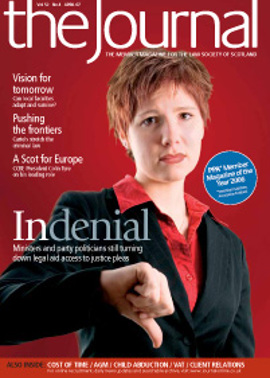Jury questions

A matter of policy
It is an odd thing that, while the content of a judge’s charge to a jury can be subjected to close scrutiny, what the jury understands and applies is not so treated unless verdicts themselves are self-contradictory or the jury itself asks for further instructions. Now and again, of course, a jury may lift the veil, at least to the extent of calling into question the actings of some fellow members.
That is what happened in Ready v HMA [2007] HCJAC 15; 2007 GWD 07-110. The first intimation of something unusual happening was when one jury member later wrote to the sheriff who had presided over the trial, making allegations about the conduct of three fellow jurors. In particular they had failed to consider the evidence, had declined to discuss it with fellow jurors and had returned a verdict to get proceedings over as quickly as possible. It was argued on appeal, with reference to Swankie v HMA 1999 SLT 1225, that there should be an investigation. The appeal was refused, it being held that all discussions by juries were to be seen as part of the jury’s general deliberations unless what happened fell within the category of exceptions proposed in R v Mirza [2004] 2 Cr App R 8. It was observed that at times one juror might well regard the attitude of another as unsatisfactory, but for reasons of public policy this was not the sort of thing that could be gone into. Doubt was also expressed as to the soundness of the opinion in Swankie that an inquiry might take place even if it amounted to an investigation into the jury’s deliberations.
More jury matters are dealt with in Rooney v HMA [2007] HCJAC 1; 2007 GWD 08-138, which was a successful appeal on the comparatively unusual ground that a verdict was unreasonable. The appellant had been convicted of culpable homicide of a man, J. The appellant was one of a number of men who were said to have gone to J’s house and assaulted him and his son S. In particular, the appellant was said to have fought with S to prevent him going to J’s assistance. This charge was found not proven.
It was held that if the appellant were to be found guilty by way of concert in the fatal assault on J, then he would of necessity have to have been found guilty of the assault on S. The verdict of the jury was accordingly found to lack rationality and to be one which no reasonable jury, properly directed, could have returned.
Mixed statements before the jury
The whole business of the mixed statement is gone into in a useful way in Robinson v HMA 2007 GWD 09-161. The case does not break any new ground, but provides an example of the law in action in this sometimes tricky area. The appeal was a successful one against a conviction for robbing a man of a sum of money and a ticket. The appellant gave a statement to the police to the effect that he was one of two men who approached the complainer and asked for money, that the other man had been aggressive to the complainer and that they had all gone to an off sales shop together. The court held that it had been incumbent on the trial judge to tell the jury that this statement was in part incriminatory and in part exculpatory, that both parts were available to them for consideration, and they must acquit if the exculpatory parts of the statement raised a reasonable doubt. Failure to do so amounted to misdirection leading to a miscarriage of justice.
Mixed statements were also considered in the case of McGirr v HMA [2007] HCJAC 7; 2007 GWD 04-59. There it was emphasised that it was for the presiding judge to decide whether or not the statement was a mixed one, and the matter of so deciding should not be left to the jury. If it was, and the Crown led evidence of it, the jury had to be told that the contents were available for and against the accused, whether he gave evidence or not, and that if the exculpatory parts were believed or raised sufficient doubts the accused should be acquitted. In this case it had actually been left to the jury to decide whether or not the statement was a mixed one, which was an error, but the appeal court held that the trial judge had in the circumstances been sufficiently explicit in telling the jury that they could take the interview into account in considering the central issue, which was provocation.
CCTV and corroboration
There can be no doubt that the arrival and subsequent spread of CCTV systems has had a far-reaching effect on our trials. The most common feature thereby introduced would seem to be delay, with summary cases being held up while the whole matter is gone into to ascertain whether there is anything to look at, and if there is, what it seems to show. More evidentially, there is the question of what use is to be made of what is recovered. In Robertson v HMA [2007] HCJAC 12; 2007 GWD 07-109, footage was shown to a jury without certificates in terms of s 283 of the Criminal Procedure (Scotland) Act 1995 being brought to the jury’s attention. The appeal, which was not successful, was on the ground that there was not sufficient evidence available to corroborate the complainer’s evidence that the appellant assaulted him. Two police officers familiar with the system had viewed the excerpt and spoke as to the time and place of the matters displayed and also to the content, which appeared to show the appellant assaulting the complainer. In spite of it being argued that this evidence was purely hearsay, the appeal court held that the excerpts showed the appellant assaulting the complainer at a date and time consistent with his account and thus were capable of corroborating his evidence.
Obviously the use of CCTV evidence has gone rather beyond what it was originally used for, namely to allow a witness to demonstrate by reference to it that what he had observed, at first hand and in real time, had actually been filmed happening. In particular, it does not seem far to go from this decision to holding that CCTV evidence of itself can corroborate an eyewitness.
Bottom line
The new(ish) doctrine of reduction of sentence for an early plea etc has thrown up some surprising appeals. In McGhee v HMA 2007 GWD 04-60, a sheriff’s decision to impose a sentence of five years’ imprisonment was said to have been incompetent as its imposition involved the sheriff making an assessment of the otherwise appropriate sentence at more than five years. The appeal did not succeed, it being held that the restriction on sentence imposed by
s 3(3) of the Criminal Procedure (Scotland) Act 1995 fell to be applied to the actual sentence imposed. Sometime you can test the good sense of a proposition by asserting its opposite; had this appeal succeeded, cases in which the sheriff ruled out a remit to the High Court would nevertheless have had to go there for the discount to be imposed, always assuming that the judge there took the same view as the sheriff.
Important distinction
We do not often cross the border on criminal law matters: deplorably insular, no doubt, but for those of us brought up on Lord Cooper and the integrity of Scots law, to do so smacks of undue attention to strange gods. All the same, an exception should be made in the case of R v Richardson [2006] EWCA Crim 3186, which sees the English Court of Appeal applying its mind to the state of the law as regards death by reckless and death by careless driving, in the light of recent increases in maximum penalties. This involved a reconsideration of R v Cooksley [2003] 3 All ER 40, which was followed in Scotland in HMA v Macpherson 2004 SCCR 579 and Dingwall v HMA 2005 SCCR 700.
So far as causing death by dangerous driving is concerned, four categories with appropriate penalties were proposed, namely:
- No aggravating circumstances – one to two years’ imprisonment
- Intermediate culpability – two to four and a half years
- Higher culpability – four and a half to seven years
- Most serious culpability – seven to 14 years.
So far as causing death by careless driving is concerned, the court said that unless alcohol was involved, culpability was always at the lowest possible scale. It was said too that drink-induced carelessness is culpable in a way that the same errors made by a sober driver are not. Finally, and presumably in a laudable attempt to limit the harm done by the illogical insistence, against best advice, of the legislature in introducing the crime of causing something by an act of carelessness, the court emphasised that it would no longer be appropriate to elide the difference between dangerous and careless driving. In future, in order to achieve fair and balanced sentencing, the difference would have to be understood and acknowledged.
In this issue
- The bigger picture
- Citizen justice
- Purely rhetoric?
- Purely rhetoric? (1)
- Profit, team by team
- Bring them home
- Bring them home (1)
- Local roots
- Wanted! (for conspiracy)
- One voice
- AGM report
- Dealing positively with client concerns
- Block fees: the story behind the changes
- Think before you charge
- For the high jump
- Jury questions
- Put to the test
- Yet another expense
- Planning with people
- Lifting the lid
- Website reviews
- Book reviews
- Home is where the heart is
- PSG - new certificate of title
- SEPA: apply online and save
- SEPA: apply online and save (1)






